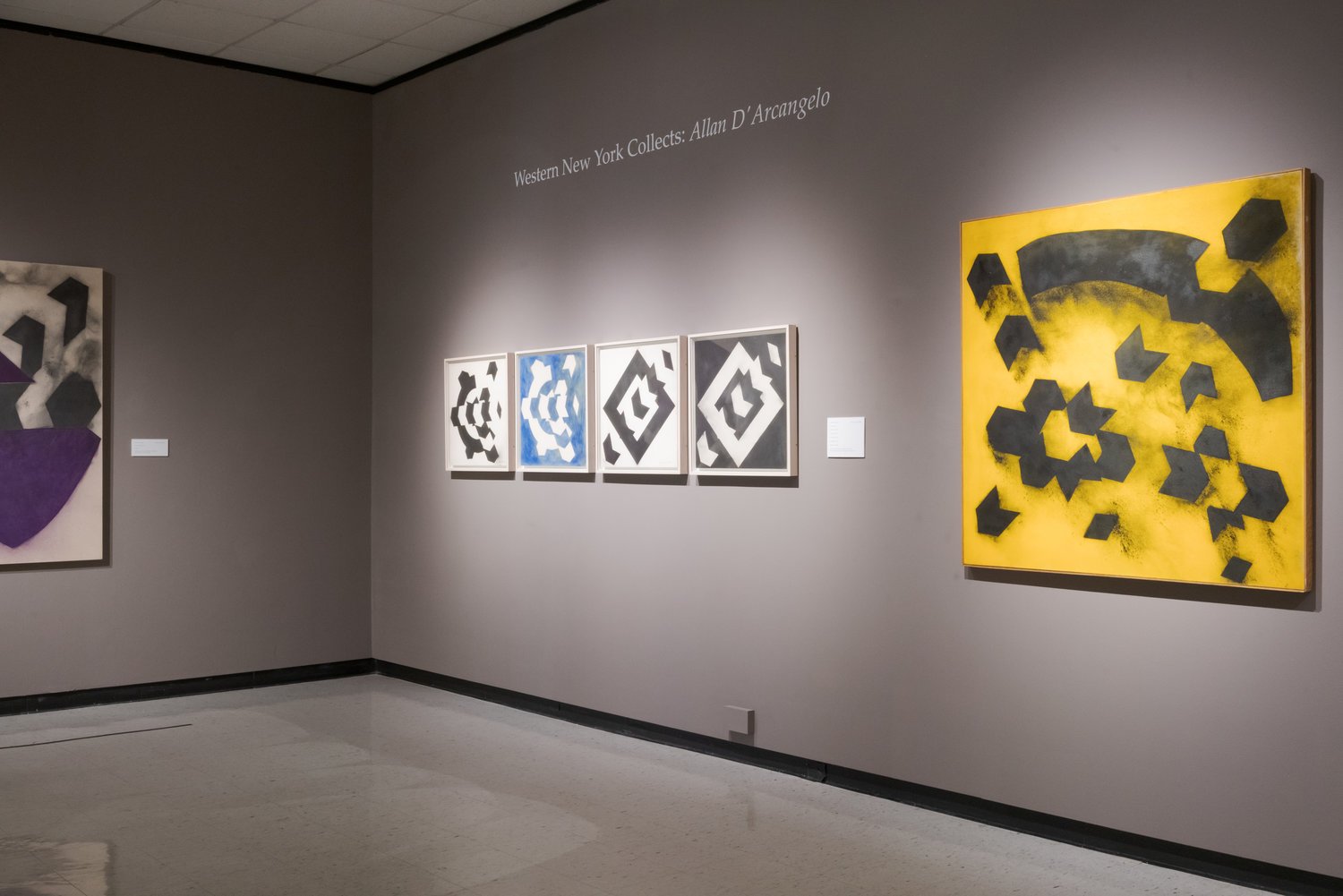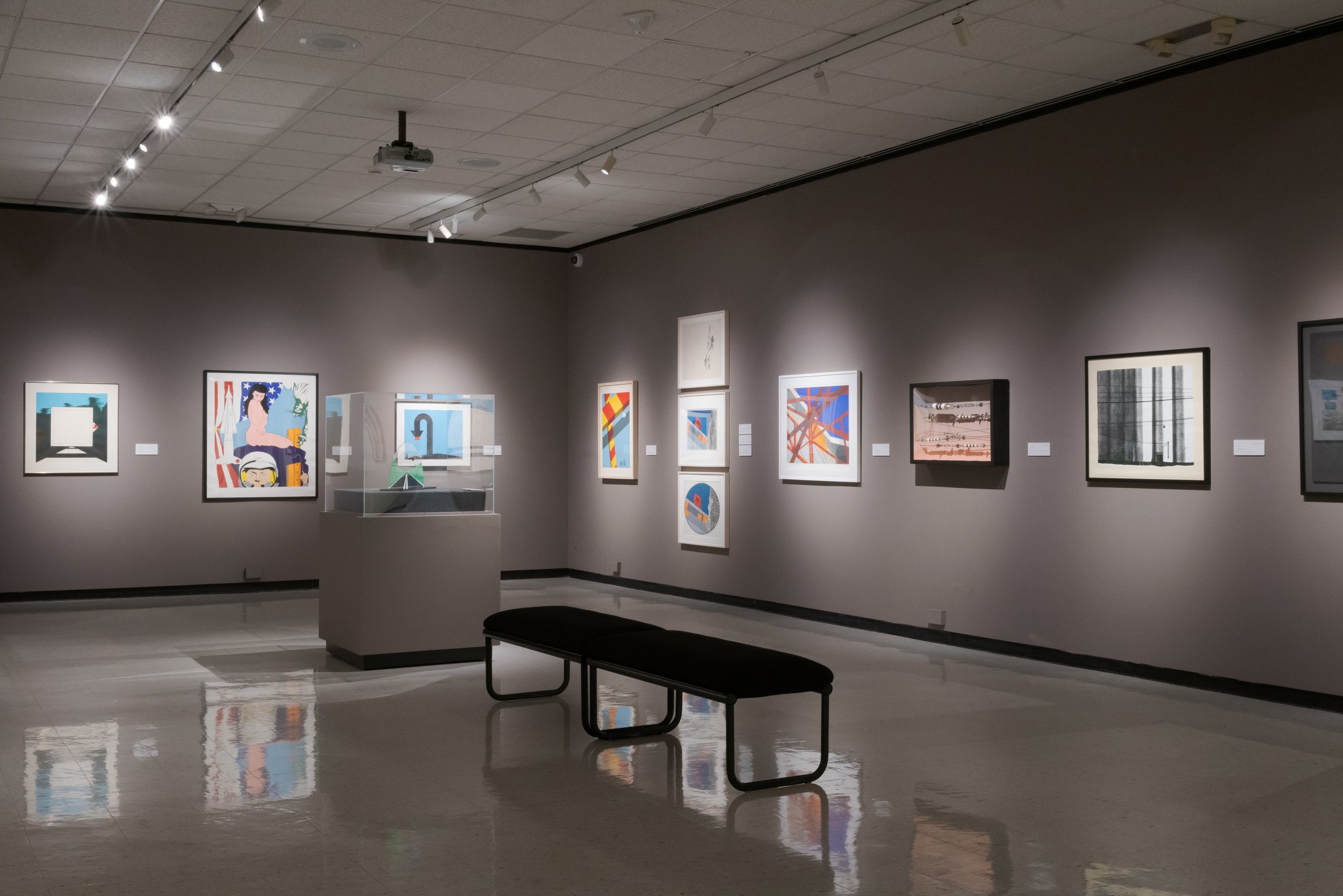Western New York Collects: Allan D’Arcangelo
by :
Jack Edson
Allan D’Arcangelo, American Madonna #1 (1978). Photo: Nando Alvarez-Perez/Courtesy the photographer
Twenty-three sculptures, drawings, and colorful prints, now on display at the Castellani Art Museum, represent a large slice of the career and aesthetics of artist Allan D’Arcangelo, who was born in Buffalo, New York, in 1930. This exhibition is representative of the resurgence of interest in D’Arcangelo’s work. This year, there are two shows of his work planned in the Western New York area alone; the other, Allan D’Arcangelo: A Print Retrospective, is scheduled to open at Sugar City in September.
Pieces in this exhibition, the most recent in the museum’s “Western New York Collects” series, were culled from the collections of Western New York museums and private collections. Past exhibitions in the series have featured work by Arnold Mesches, Josh Iguchi, Cindy Sherman, and Nancy Dwyer. According to Curator of Exhibitions and Special Projects Michael Beam ‘Western New York Collects’ is a biannual celebration of favorite artists who have a connection to our area that gives the museum an opportunity to get in touch with area collectors. In this case, that included a member of the artist’s family. In addition, two pieces were owned by Dr. and Mrs. Armand J. Castellani, the founders of the Castellani Art Museum itself.
From the moment one enters the gallery, the artist’s visual punch, and bold aesthetics nearly jump off the walls. The display is enhanced by the dark mauve–painted walls and the central placement of the artist’s powerful works. D’Arcangelo is best known for his theme of the American highway: that black triangular slice of road with its pulsing, painted lines leading into the distance on some never-ending road trip. These highways are often seen through an automobile windshield, as in Holy Family with its pair of baby booties hanging from the rearview mirror, or in D’Arcangelo’s first print, Untitled (1966), which shows a landscape blurred in motion. The sculpture Day and Night (Rearview Mirror and Windshield) from 1970 takes the shape of an automobile’s glass windshield with an attached rearview mirror, showing the daytime highway scene on the windshield and the nighttime highway scene on the mirror. We see the road ahead and the road behind.
During his lengthy career, D’Arcangelo also used other mediums with similar concepts. He made films, including a conceptual piece that he filmed using two cameras in a moving automobile, one filming the road ahead and the other pointed out the back window toward the landscape that the travelers were leaving behind. These films were intended to be shown simultaneously, and they were about travel, not reaching a particular destination.
The artist’s Constellations period is abundantly represented in this exhibition, which includes four smaller pieces from 1971; a larger, more complex work on a mustard ground from 1972; and a large beauty with a gleaming purple background. While his highway works show landscapes that could extend beyond the limits of the canvas, the Constellations are usually shapes based on road barriers and their designs are held neatly within the canvas borders.
Allan D’Arcangelo, Western New York Collects (2019). Photo: Nando Alvarez-Perez/Courtesy the photographer
Modern Superhighway through Countryside, a painting from 1969, includes the image of a vertical red and white highway barrier, similar to those in his Constellations series, within a landscape, as well as an actual postcard that serves as the source image of the larger landscape in this piece. Similar to Charles E. Burchfield’s practice of using smaller pieces made during his golden year of 1916 and adding more paper and more landscape during his later years.
A series of three pieces—Sketch for print commissioned by the Jewish Museum, Keyline drawing for print commissioned by the Jewish Museum, and Print commissioned by the Jewish Museum—loaned from the collection of the Burchfield Penney Art Center, demonstrates the artist’s method of creating a print commissioned by the Jewish Museum in 1976. Across the three works, we see D’Arcangelo planning and working through his process from the color sketch, to the keyline drawing, to the finished print.
The artist traveled and taught widely throughout his life, but maintained ties with friends and family in Buffalo. The lithograph print Grain Elevators shows a wall of concrete grain elevator silos like those still found today on Buffalo’s waterfront in their black-and-white, sunlit, and shaded glory. This beautiful piece was made for the 1979 D’Arcanglelo exhibition, The American Landscape, at what was then called the Burchfield Center.
Of particular note are two large silkscreen prints, American Madonna #1 and Icarus (both 1978), complex and colorful figurative works uniting several images from popular culture, as the artists of the Pop art movement also did. American Madonna # 1 has it all: a statuesque female nude—with a halo no less—a reversed American flag, lettering you might find on a packing crate. All this rests above the heads of the serious older couple from the iconic painting American Gothic by Grant Wood. Not to be outdone, Icarus takes everything a little farther, offering a beguiling nude profile of the famous pin-up model Bettie Page alongside a tearful portrait of astronaut John Glenn, a nuclear missile, an upside-down Lady Liberty, a tattooed hand of a sailor holding a cigarette, and once again, the stars and stripes of Old Glory. The title reminds us that just as Icarus flew too close to the sun and fell to the earth, astronaut John Glenn nearly lost his life during a space flight in 1962.
Collector and scholar, Gerald Mead, Jr. co-curated this exhibit with Michael Beam, and Mead’s enthusiasm for the artists of Western New York and his knowledge of area collections make this exhibit a great success, demonstrate the greatness of this Buffalo son.
Allan D’Arcangelo, Western New York Collects (2019). Photo: Nando Alvarez-Perez/Courtesy the photographer
Allan D’Arcangelo, Western New York Collects (2019). Photo: Nando Alvarez-Perez/Courtesy the photographer
Allan D’Arcangelo, American Madonna #1 (1978). Photo: Nando Alvarez-Perez/Courtesy the photographer
Jack Edson is a collector and quilt artist from Hamburg, New York.
Image: Allan D’Arcangelo, American Madonna #1 (1978). Photo: Nando Alvarez-Perez/Courtesy the photographer
Western New York Collects: Allan D’Arcangelo
June 23 – December 13, 2019
Castellani Art Museum
5795 Lewiston Road, Niagara University NY 14109
Editorial Note: Jack Edson collects works by Allan D’Arcangelo, and owns works in this exhibition.





